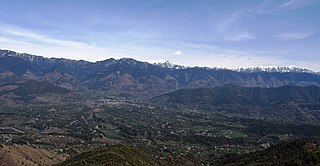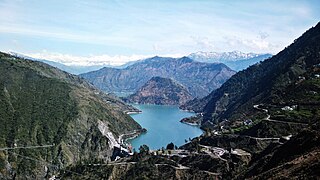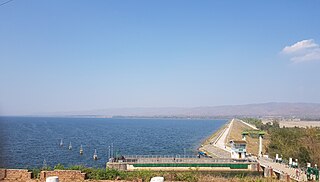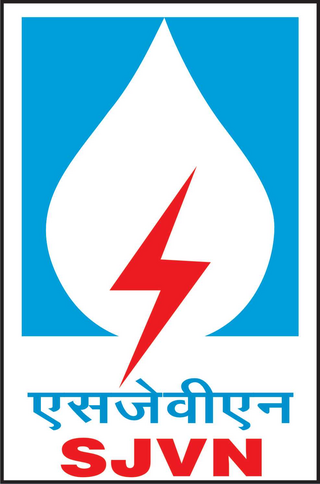Related Research Articles

Kullu is a district in Himachal Pradesh, India. It borders Shimla district to the south, Mandi and Kangra districts to the west, Kinnaur to the east and the Lahaul and Spiti district to the north and east. The largest valley in this mountainous district is the Kullu Valley. The Kullu valley follows the course of the Beas River, and ranges from an elevation of 833 m above sea level at Aut to 3330 m above sea level at the Atal Tunnel South Portal, below the Rohtang Pass. The town of Kullu, located on the right side of the Beas River, serves as the administrative headquarters of the Kullu district. The Kullu district also incorporates several riverine tributary valleys of the Beas, including those of the Parvati, Sainj, and Tirthan rivers, and thus some regions somewhat distant from the Kullu valley. The economy of the district relies mainly on horticulture, agriculture, tourism, and traditional handicrafts.

The Jhelum River is a river in the northern Indian subcontinent. It originates at Verinag and flows through the Indian-administered territory of Jammu and Kashmir, into Pakistan-administered Azad Kashmir, then the Pakistani province of Punjab. It is the westernmost of the five rivers of the Punjab region, and flows through the Kashmir Valley. It is a tributary of the Chenab River and has a total length of about 725 kilometres (450 mi).

Teesta River is a 414 km (257 mi) long river that rises in the Pauhunri Mountain of eastern Himalayas, flows through the Indian states of Sikkim and West Bengal and subsequently enters Bangladesh through Rangpur division. In Bangladesh, it merges with Brahmaputra River which after meeting some other major rivers of the Bengal delta finally falls into the Bay of Bengal. It drains an area of 12,540 km2 (4,840 sq mi). In India, the Teesta flows through Mangan District, Gangtok District, Pakyong District, Kalimpong district, Darjeeling District, Jalpaiguri District, Cooch Behar districts and the cities of Rangpo, Jalpaiguri and Mekhliganj. In Bangladesh, it flows through Lalmonirhat District, Rangpur District, Kurigram District and Gaibandha District. It joins the Brahmaputra River at Phulchhari Upazila in Bangladesh. 305 km (190 mi) of the river lies in India and 109 km (68 mi) in Bangladesh. The Teesta is the largest river of Sikkim and second largest river of West Bengal after the Ganges.
The Indira Sagar Dam is the largest dam in India, in terms of volume of water stored in the reservoir. It is located on the Narmada River at the town of Narmada Nagar, Punasa in the Khandwa district of Madhya Pradesh in India. The foundation stone of the project was laid by the prime minister of India Indira Gandhi on 23 October 1984. The construction of the main dam started in 1992. The downstream projects of ISP are Omkareshwar, Maheshwar, and Sardar Sarovar Project. To build it, a town of 22,000 people and 100 villages was displaced.

Salal Dam, also known as Salal Hydroelectric Power Station, is a run-of-the-river hydropower project on the Chenab River in the Reasi district of the Jammu and Kashmir. It was the first hydropower project built by India in Jammu and Kashmir under the Indus Water Treaty regime. After having reached a bilateral agreement with Pakistan in 1978, with significant concessions made to Pakistan in the design of the dam, reducing its height, eliminating operating pool, and plugging the under-sluices meant for sediment management, India completed the project in 1987. The concessions made in the interest of bilateralism damaged the long-term sustainability of the dam, which silted up in five years. It currently runs at 57% capacity factor. Its long-term future is uncertain.

Jogindernagar, or Jogindar Nagar, is a municipality, and a sub district in Mandi district in the Indian state of Himachal Pradesh. Named after Raja Joginder Sen, the hill station is the terminus of the 163-kilometre-long (101 mi) Kangra Valley narrow-gauge railway. Jogindernagar is the third-largest city in the Mandi district. The only city in Asia with three hydro-electric power stations, its nickname is "The City of Powerhouses".

The Indian state Himachal Pradesh has a large number hydroelectricity resources, about twenty five percent of the national potential. About 27,436 MW of hydroelectric power can be generated in the state by the construction of various hydroelectric projects on the five perennial river basins. Out of total hydroelectric potential of the state, 10,519 MW is harnessed so far, out of which 7.6% is under the control of Himachal Pradesh Government while the rest is exploited by the Central Government. The state government has been giving the highest priority for its development, since hydroelectric generation can meet the growing need of power for industry, agriculture and rural electrification. It is also the biggest source of income to the state as it provides electricity to other states.

NHPC Limited is an Indian public sector hydropower company that was incorporated in 1975 to plan, promote and organise an integrated and efficient development of hydroelectric power. Recently it has expanded to include other sources of energy like solar, geothermal, tidal, and wind.

The Chamera Dam impounds the River Ravi and supports the hydroelectricity project in the region. It is located near the town of Dalhousie, in the Chamba district in the state of Himachal Pradesh in India. The reservoir of the dam is the Chamera Lake. Large part of its reservoir lies in Salooni sub-division of Chamba.
Dul Hasti is a 390 MW hydroelectric power plant in Kishtwar district of Jammu and Kashmir, India built by NHPC. The power plant is a run-of-the-river type on the Chenab River, in a rugged, mountainous section of the Himalayas, and several hundred kilometers from larger cities in the Jammu Division. It consists of a 70 m (230 ft) tall gravity dam which diverts water through a 9.5 km (5.9 mi) long headrace tunnel to the power station which discharges back into the Chenab. The project provides peaking power to the Northern Grid with beneficiary states being Jammu and Kashmir, Punjab, Haryana, Uttar Pradesh, Uttarakhand, Rajasthan, Delhi and Union Territory of Chandigarh. It was constructed between 1985 and 2007.

There are almost 200 large dams in Myanmar. Myanmar (Burma) has a large hydroelectric power potential of 39,000 megawatts (52,000,000 hp), although the economical exploitable potential is about 37,000 megawatts (50,000,000 hp). Between 1990 and 2002, the country tripled its installed capacity of hydro plants, increasing from 253 megawatts (339,000 hp) to 745 megawatts (999,000 hp). Total installed capacity in 2010 is at least 2,449 megawatts (3,284,000 hp) MW, 6% of potential. Several large dams are planned to increase future hydro utilization.

Rangit Dam, which forms the headworks of the Rangit Hydroelectric Power Project Stage III, is a run-of-the-river hydroelectric power project on the Ranjit River, a major tributary of the Teesta River in the South Sikkim district of the Northeastern Indian state of Sikkim. The project's construction was completed in 1999. The project is fully functional since 2000. The project was built at a cost of Rs 4922.6 million. The average annual power generation from the 60 MW project is 340 GWh with firm power of 39 MW.

JSW Energy Limited is an Indian power company engaged in power generation, transmission and trading. It is part of JSW Group.
Chamera II is a run of the river hydroelectric dam built by NHPC India. It is a 300 MW project built on the Ravi River in Himachal Pradesh. It was commissioned in March 2004.

The Chutak Hydroelectric Plant is a run-of-the-river power project on the Suru River in Kargil district in the Indian union territory of Ladakh. The barrage of the project is at Sarze village and the powerhouse is located on the right bank of the Suru near Chutak village. The project construction began on 23 September 2006, and the first three generators were commissioned in November 2012. The fourth was commissioned in January 2013.

The Koldam Hydropower Station, commonly known as Koldam, is an embankment dam on the Sutlej River upstream of the Dehar Power House. It is 18 km from Bilaspur off the Chandigarh-Manali Highway (NH-21) near Barmana, Himachal Pradesh, India. The main purpose of the dam is hydroelectric power generation and it will support an 800 MW power station. The dam was constructed by NTPC Limited.
Lakhwar-Vyasi Dam project on Yamuna River, includes under-construction Lakhwar Dam and Power Station, Vyasi Dam, Hathiari Power Station and Katapathar Barrage, near the Lakhwar town in Kalsi block of Dehradun district of Uttarakhand in India, for the purpose of irrigation of 40,000 hectare land and total 927 MW hydroelectric power generation. "Lakhwar Dam" is a gravity dam near the Lohari village with 300MW power generation capacity. "Vyasi Dam" will be built 5 km downstream along with 120 MW "Hathiari Power Station" further 0.5 km downstream. "Katapathar Barrage", with the maximum ponding water level at 514.5m elevation, will be built further 2.75 km downstream of the Hathiari Power Station to supply the water to stakeholder states. Project will hold 580 million cubic metres water during monsoon and release into Yamuna during dry months.
The Nachtigal Hydroelectric Power Station is a 420 megawatt run-of-the-river hydroelectric power station under development in Cameroon across the Sanaga River, which harnesses the energy of the Nachtigal Falls. The development rights were granted to Nachtigal Hydro Power Company (NHPC), a company owned by a consortium comprising (a) Électricité de France (b) International Finance Corporation and (c) the Government of Cameroon. A 35-year power purchase agreement is in place, between Eneo Cameroon S.A. and NHPC.

SJVN, formerly known as Satluj Jal Vidyut Nigam, is an Indian public sector undertaking in the Navratna Category which is involved in hydroelectric power generation and transmission. It was incorporated in 1988 as Nathpa Jhakri Power Corporation, a joint venture between the Government of India and the Government of Himachal Pradesh. The company has a total operating hydropower capacity of 1912 MW through its two hydropower plants—Nathpa Jhakri and Rampur. In addition, it has an installed capacity of 97.6 MW of wind power and 81.9 MW of solar power.
References
- ↑ "NHPC Limited : Projects : Power Stations : Parbati - III". www.nhpcindia.com. Retrieved 30 March 2022.
- ↑ "Patel Engineering :: Projects". www.pateleng.com. Retrieved 24 April 2022.
- ↑ "Parbati-II Hydroelectric Power Project, Himachal Pradesh - NS Energy" . Retrieved 8 April 2022.
- ↑ "Parbati-II Hydroelectric Power Project, Himachal Pradesh - NS Energy" . Retrieved 8 April 2022.
- ↑ "Machinery damaged in fire at NHPC Parbati stage-2 project in Himachal's Kullu district". Hindustan Times. 30 July 2020. Retrieved 24 April 2022.
- ↑ Asher, Manshi (7 February 2022). "A Year Since Chamoli Disaster, Himachal's Dam-Building Spree Unabated – The Wire Science" . Retrieved 24 April 2022.
- ↑ "NHPC Limited : Projects : Power Stations : Parbati - III". www.nhpcindia.com. Retrieved 8 April 2022.